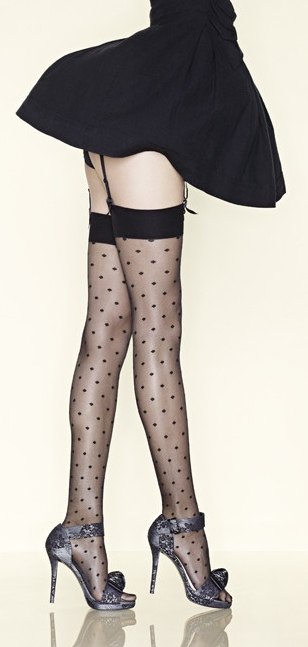Choosing the Right Tights: Hosiery Explained
Picking the perfect dress is the first step to looking gorgeous on your wedding day, the second is selecting the right hosiery to complement your outfit. If you don’t know your sheer from your spandex, here’s a handy guide that unravels the perplexity of hosiery.
Pantyhose, knee highs, stockings, tights and leggings, these are just some of the types of leg coverings that fall under the general term hosiery. Many people might consider them the realm of an older generation, but with some rather racy styles available, you’ll certainly be able to spice up your wedding night.
(Courtesy part-l-ypoison.tumblr.com)
Hosiery should act like your foundation – improving your look without really being noticed. It hides skin imperfections, provides uniform colour and highlights the shape of your shapely legs. For your wedding, you’ll likely choose between wearing stockings and pantyhose.
Stockings
Your memory of stockings (together with hairspray and rose talcum powder) may remind you of your grandmother, but they’ve taken a sensual turn since they were first created. Stockings come in pairs – one for each leg – and they cover from the foot up to the thigh. There are three types:
– The earliest stockings were held up using a garter – a ring of fabric that was slipped over the stocking, and tied near the knee to prevent it from falling down. Garters today are more traditional than functional, and one- usually made from ornate lace – is worn at a wedding for the garter toss.
– In the early 20th century women began using a garter belt, or suspender belt, to keep stockings up. It’s a piece of lingerie that’s worn around the waist, with four or six straps that hang down, and get clipped onto the top of the stocking.
– To make stockings easier to use and to eliminate suspender bumps, stay-ups or hold-ups were created. These have a band of tractive material, such as silicon or elastic, on the top and inside of each stocking, to prevent it from sliding down the thigh. On the outside is usually a wide scalloped lace top.
Stockings are both sexy and functional, and they’re synonymous with old fashioned glamour. They don’t bunch at the waist, are less restrictive than pantyhose, and allow more ventilation in your nether regions. This is good for hygiene and it also keeps you cooler in the warmer months. Contrary to their name, stay-ups don’t always stay up, and for that reason a suspender belt is the most popular way to keep your stockings in the right place.
(Courtesy lilleboutique.com)
Pantyhose/ Tights
These first made their appearance during the 1940s and 1950s, and because they were more convenient, they began to encroach on the stocking domination. Pantyhose extend from the toes up to the waist, where it’s held in place by an elasticated waistband, and it usually has a reinforced crotch. There are different types of pantyhose, including:
– Regular. These are the simplest kind and they’re soft, stretchy and easy to wear.
– Control top. Extra spandex allows more stretching, and the thicker material at the top provides additional support for the tummy and thighs, while also lifting and shaping the buttocks. You have a variety of control options to help create a smooth silhouette.
– Sheer-to-waist. This is sheer from your toes to your waist, which means no panty lines and a smooth continuous form.
– Body shaper. This longer line control top can extend down to the thighs, giving you the greatest amount of support. Waist, hips and thighs are streamlined and, depending on the control option you choose, you can also gain a pert derrière.
Pantyhose are an easier option to put on and take off, and you don’t have to worry about anything slipping down as you walk. The bonus is that they usually come with a slimming feature, which helps you achieve fabulous curves. There are hygiene concerns about nylon, but for most women this isn’t a problem if they’re worn for a short period of time. They’ll keep you warmer if your wedding is in the cooler months, and they prevent your thighs and feet from chafing.
Once you’ve chosen between pantyhose and stockings, your job isn’t done, because you also need to consider classification, colour and comfort. The thickness of hosiery is measured in deniers, the lower the denier the more sheer and fragile the item, the higher the denier the more opaque and durable it becomes. It’s important to bear in mind that there are also huge varieties of styles between different lingerie brands.
(Courtesy lilleboutique.com)
Classification
– Ultra sheer. This is the next best thing to going bare and it perfectly shows off the shape of your pins. Blemishes are smoothed out, it’s ideal for hot weather and it’s perfect for glamorous evenings. It has a denier of 15 or less, so your natural skin tone shines through.
– Sheer. It’s a slightly thicker option and is more durable, but is still soft and silky. It is more noticeable that you’re wearing stockings, but a good quality brand will give your legs an even, natural appearance. The denier is between 15-30 and this makes it less likely to ladder.
– Semi-opaque. Stronger and more hardy than sheer, these give your legs good coverage and your skin is still visible. The denier is usually between 30 and 40.
– Opaque. This is the thickest member of the hosiery family and they’re often referred to as tights. With a denier of 40 and up, you won’t see your skin through the fabric, which can make your legs seem heavy, but you will be warm, which works for a winter wedding.
(Courtesy thetightspot.com)
Colour
Every lingerie company has a slightly different interpretation of shade, which can make this quite tricky. From English Rose and Linen, to Ivory and Petal, be sure to match your skin tone as closely as possible – don’t choose a sun-kissed shade when the rest of you is alabaster. Depending on the thickness of your dress, you may be able to see white hosiery through it, so it’s best to choose natural, nude hues. If you’re a bold bride, pick a vivid colour, or opt for something more romantic, with a hint of sparkle, so that you shimmer as you walk. There are also quirky styles with cute but subtle bows, hearts and floral designs.
Comfort
If you do choose to wear hosiery on your wedding day, you’ll be wearing it for the entire day- so make sure you pick something that fits you well so you don’t keep tugging and fidgeting. You want the right size, shape and style for your body, and that means finding a pair long before you walk down the aisle. Try them on and be sure to sit, kneel and dance around, so you’re completely comfortable. Sizing isn’t standard, particularly with cheaper brands, so check the measurements on the hosiery box to see what you need. If you’re at the top end of the range then go up a size. If it’s too tight it’s more susceptible to tearing, you may bulge in places you don’t want to bulge, and you’re likely to have poorer circulation. When you find what you like, buy an extra pair for backup.
Environment
There are of course other factors that influence your decision: the style of your dress, the season, the formality and your shoes. Your garter belt will show through a form-fitting sheath dress, but a full skirt will hide it. Wear a higher denier for a winter wedding, compared to a summer one, and if your wedding is formal, you should wear hosiery. If you adhere to etiquette, it’s a definite no-no to wear hosiery with open-toed shoes, even if you have an invisible seam and a sheer toe. According to these sticklers it’s no hose with open toes!
If you’re worried about having a Bridget Jones moment on your wedding night, you do have another option. Wear shape-enhancing, comfortable hosiery during the day, and slip into something femme fatale for your wedding night.
It was once considered quite scandalous to leave home without wearing stockings or pantyhose, but these days (and particularly on your wedding night!), it’s more of a private pleasure. Whatever you decide to buy, know that your husband has spent a good portion of the day wondering what you’re wearing under your wedding dress – I can guarantee he won’t be disappointed.








